fault Peugeot Boxer 2018 User Guide
[x] Cancel search | Manufacturer: PEUGEOT, Model Year: 2018, Model line: Boxer, Model: Peugeot Boxer 2018Pages: 232, PDF Size: 9.09 MB
Page 24 of 232
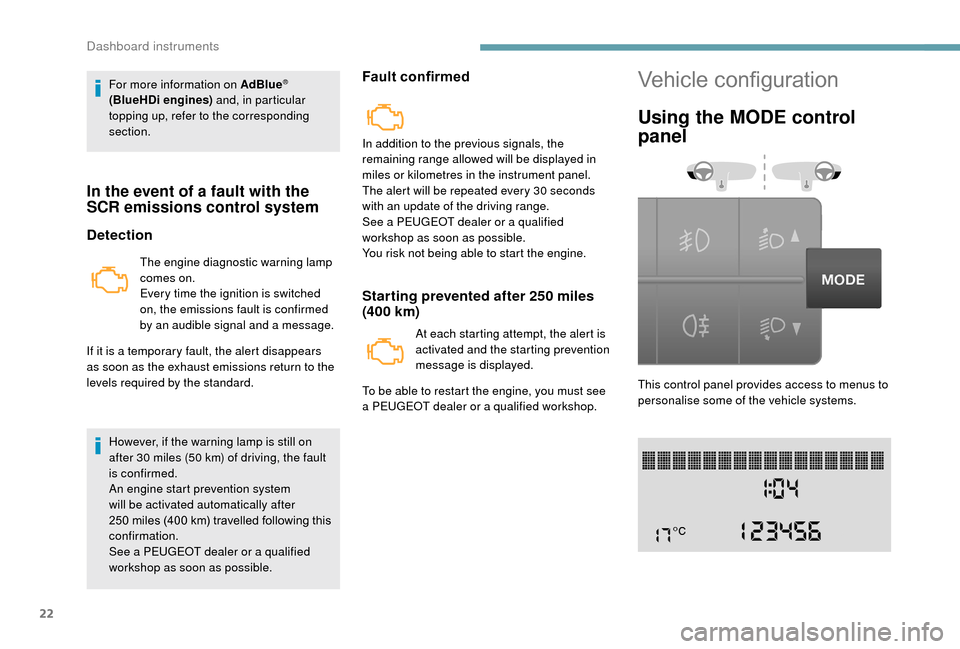
22
For more information on AdBlue®
(BlueHDi engines) and, in particular
topping up, refer to the corresponding
section.
In the event of a fault with the
S CR emissions control system
Detection
The engine diagnostic warning lamp
comes on.
Every time the ignition is switched
on, the emissions fault is confirmed
by an audible signal and a
message.
If it is a
temporary fault, the alert disappears
as soon as the exhaust emissions return to the
levels required by the standard.
However, if the warning lamp is still on
after 30
miles (50 km) of driving, the fault
is confirmed.
An engine start prevention system
will be activated automatically after
250
miles (400 km) travelled following this
confirmation.
See a
PEUGEOT dealer or a qualified
workshop as soon as possible.
Fault confirmed
In addition to the previous signals, the
remaining range allowed will be displayed in
miles or kilometres in the instrument panel.
The alert will be repeated every 30
seconds
with an update of the driving range.
See a
PEUGEOT dealer or a qualified
workshop as soon as possible.
You risk not being able to start the engine.
Starting prevented after 250 miles
( 400 km)
At each starting attempt, the alert is
activated and the starting prevention
message is displayed.
To be able to restart the engine, you must see
a
PEUGEOT dealer or a qualified workshop.
Vehicle configuration
Using the MODE control
panel
This control panel provides access to menus to
personalise some of the vehicle systems.
Dashboard instruments
Page 51 of 232
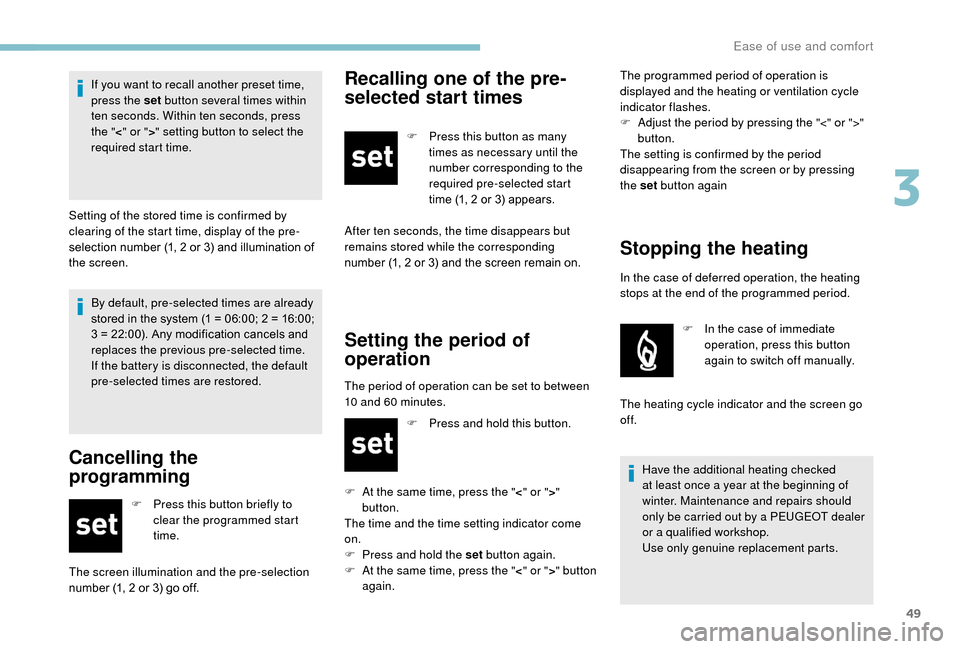
49
By default, pre-selected times are already
stored in the system (1 = 06:00; 2 = 16:00;
3 = 22:00). Any modification cancels and
replaces the previous pre-selected time.
If the battery is disconnected, the default
pre-selected times are restored.
Cancelling the
programming
F Press this button briefly to clear the programmed start
time.
The screen illumination and the pre-selection
number (1, 2
or 3) go off.
Recalling one of the pre-
selected start times
F Press this button as many times as necessary until the
number corresponding to the
required pre-selected start
time (1, 2
or 3) appears.
After ten seconds, the time disappears but
remains stored while the corresponding
number (1, 2
or 3) and the screen remain on.
Setting the period of
operation
The period of operation can be set to between
10 and 60 minutes.
F
P
ress and hold this button. The programmed period of operation is
displayed and the heating or ventilation cycle
indicator flashes.
F
A
djust the period by pressing the "<" or ">"
button.
The setting is confirmed by the period
disappearing from the screen or by pressing
the set button again
In the case of deferred operation, the heating
stops at the end of the programmed period. F
I
n the case of immediate
operation, press this button
again to switch off manually.
The heating cycle indicator and the screen go
of f.
Have the additional heating checked
at least once a
year at the beginning of
winter. Maintenance and repairs should
only be carried out by a
PEUGEOT dealer
or a
qualified workshop.
Use only genuine replacement parts.
Stopping the heating
If you want to recall another preset time,
press the set button several times within
ten seconds. Within ten seconds, press
the " <" or " >" setting button to select the
required start time.
Setting of the stored time is confirmed by
clearing of the start time, display of the pre-
selection number (1, 2
or 3) and illumination of
the screen.
F
A
t the same time, press the "<" or " >"
button.
The time and the time setting indicator come
on.
F
P
ress and hold the set button again.
F
A
t the same time, press the "<" or " >" button
again.
3
Ease of use and comfort
Page 57 of 232
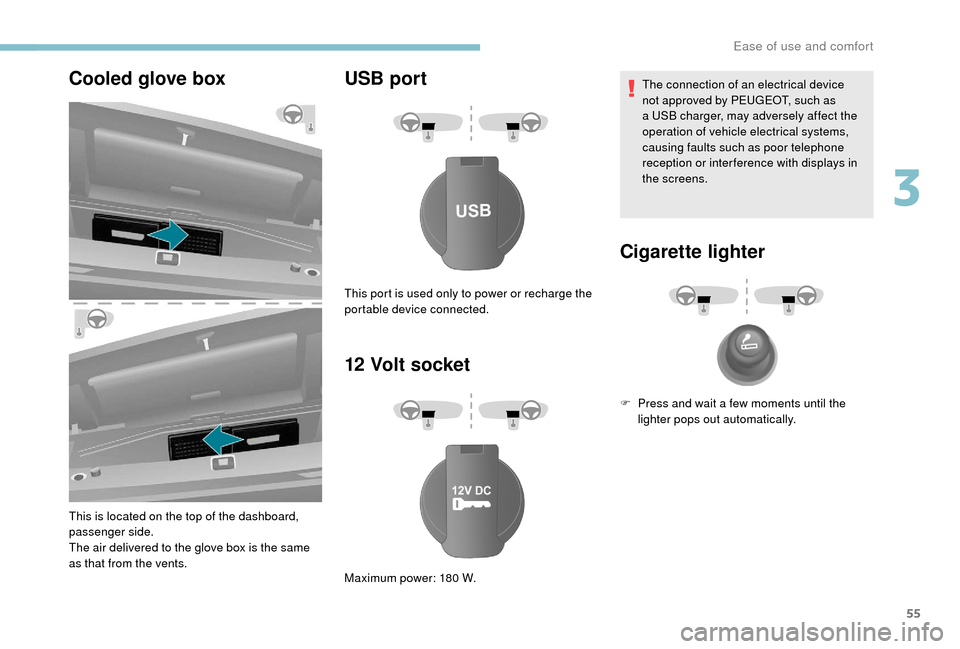
55
Cooled glove box
This is located on the top of the dashboard,
passenger side.
The air delivered to the glove box is the same
as that from the vents.
USB port
12 Volt socketThe connection of an electrical device
not approved by PEUGEOT, such as
a USB charger, may adversely affect the
operation of vehicle electrical systems,
causing faults such as poor telephone
reception or inter ference with displays in
the screens.
Cigarette lighter
This port is used only to power or recharge the
portable device connected.
Maximum power: 180
W. F
P
ress and wait a few moments until the
lighter pops out automatically.
3
Ease of use and comfort
Page 59 of 232
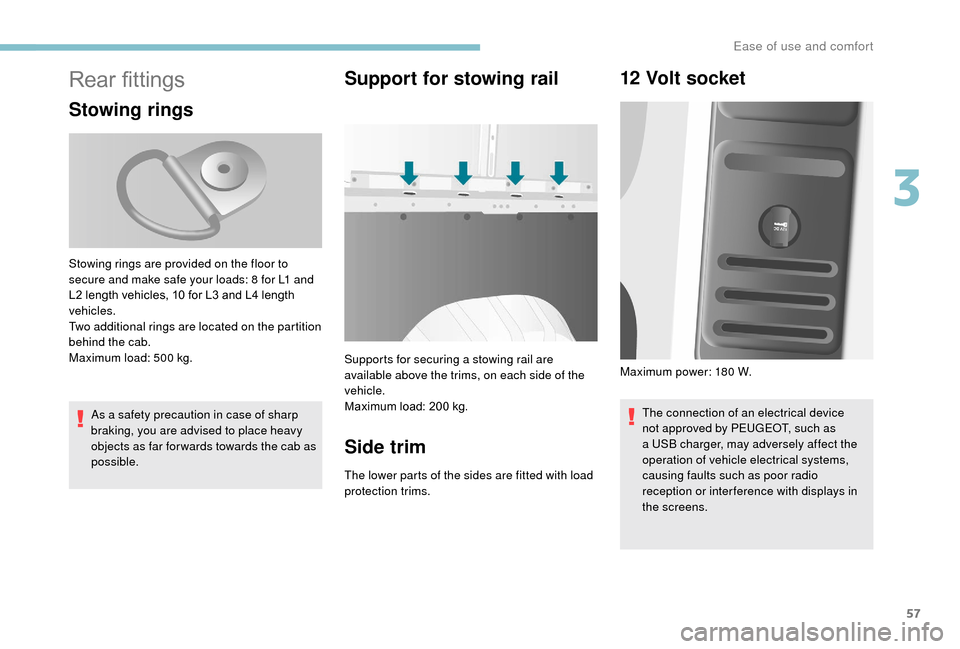
57
Rear fittings
Stowing rings
As a safety precaution in case of sharp
b raking, you are advised to place heavy
objects as far for wards towards the cab as
possible.
Support for stowing rail
Supports for securing a stowing rail are
a vailable above the trims, on each side of the
vehicle.
Maximum load: 200
kg.
Side trim
The lower parts of the sides are fitted with load
protection trims.
Stowing rings are provided on the floor to
secure and make safe your loads: 8
for L1
and
L2
length vehicles, 10
for L3
and L4
length
vehicles.
Two additional rings are located on the partition
behind the cab.
Maximum load: 500
kg.
12 Volt socket
The connection of an electrical device
not approved by PEUGEOT, such as
a
USB charger, may adversely affect the
operation of vehicle electrical systems,
causing faults such as poor radio
reception or inter ference with displays in
the screens.
Maximum power: 180
W.
3
Ease of use and comfort
Page 69 of 232
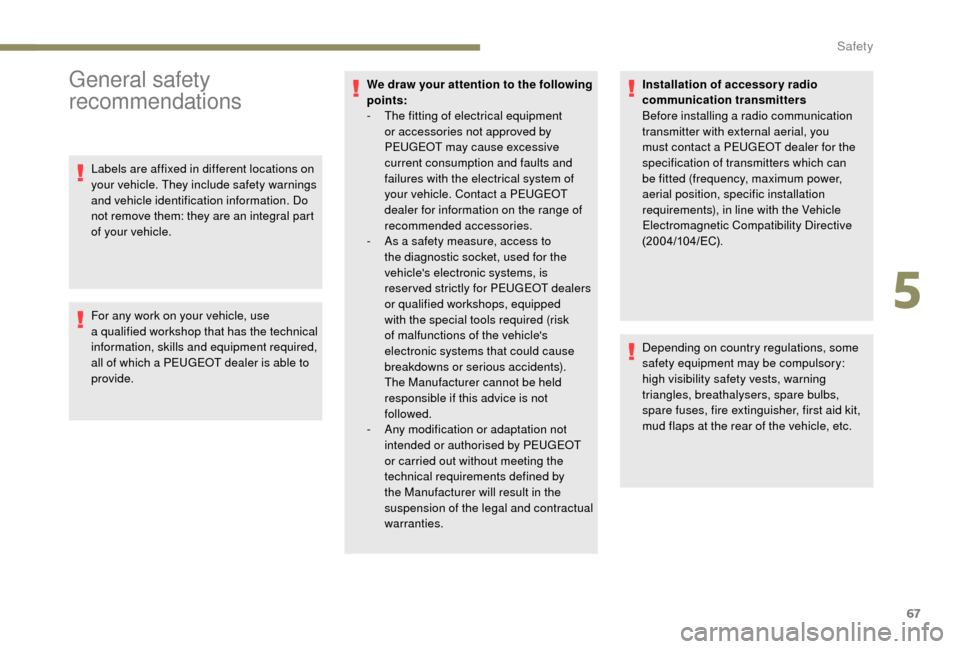
67
General safety
recommendations
Labels are affixed in different locations on
your vehicle. They include safety warnings
and vehicle identification information. Do
not remove them: they are an integral part
of your vehicle.
For any work on your vehicle, use
a qualified workshop that has the technical
information, skills and equipment required,
all of which a
PEUGEOT dealer is able to
provide. We draw your attention to the following
points:
-
T
he fitting of electrical equipment
or accessories not approved by
PEUGEOT may cause excessive
current consumption and faults and
failures with the electrical system of
your vehicle. Contact a
PEUGEOT
dealer for information on the range of
recommended accessories.
-
A
s a safety measure, access to
the diagnostic socket, used for the
vehicle's electronic systems, is
reser ved strictly for PEUGEOT dealers
or qualified workshops, equipped
with the special tools required (risk
of malfunctions of the vehicle's
electronic systems that could cause
breakdowns or serious accidents).
The Manufacturer cannot be held
responsible if this advice is not
followed.
-
A
ny modification or adaptation not
intended or authorised by PEUGEOT
or carried out without meeting the
technical requirements defined by
the Manufacturer will result in the
suspension of the legal and contractual
warranties. Installation of accessory radio
communication transmitters
Before installing a
radio communication
transmitter with external aerial, you
must contact a PEUGEOT dealer for the
specification of transmitters which can
be fitted (frequency, maximum power,
aerial position, specific installation
requirements), in line with the Vehicle
Electromagnetic Compatibility Directive
(2004/104/EC).
Depending on country regulations, some
safety equipment may be compulsory:
high visibility safety vests, warning
triangles, breathalysers, spare bulbs,
spare fuses, fire extinguisher, first aid kit,
mud flaps at the rear of the vehicle, etc.
5
5
Safety
Page 71 of 232
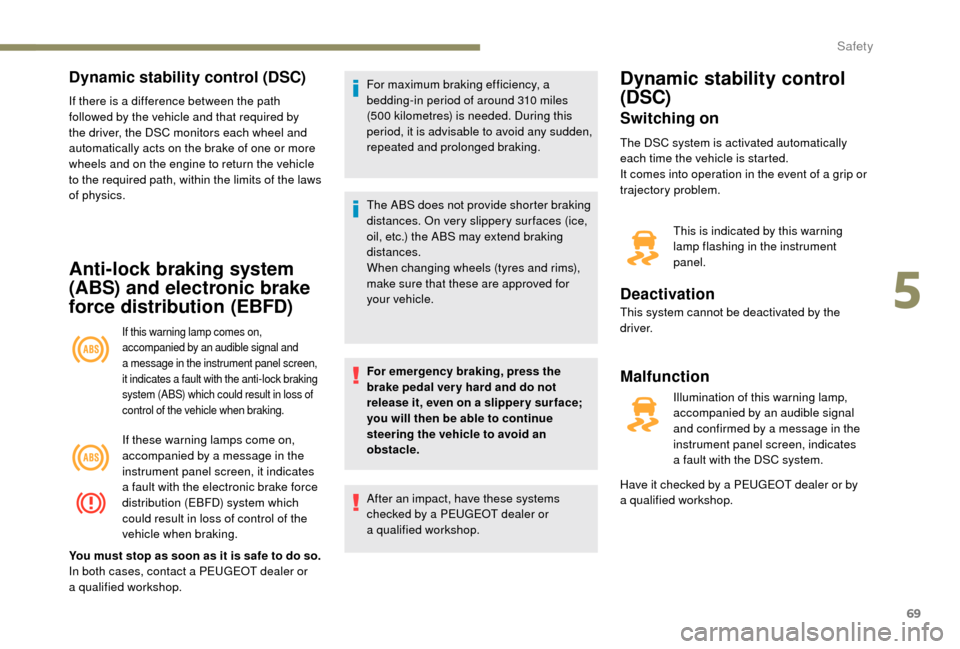
69
Dynamic stability control (DSC)
If there is a difference between the path
f ollowed by the vehicle and that required by
the driver, the DSC monitors each wheel and
automatically acts on the brake of one or more
wheels and on the engine to return the vehicle
to the required path, within the limits of the laws
of physics.
Anti-lock braking system
(ABS) and electronic brake
force distribution (EBFD)
If this warning lamp comes on,
accompanied by an audible signal and
a
message in the instrument panel screen,
it indicates a
f
ault with the anti-lock braking
system (ABS) which could result in loss of
control of the vehicle when braking.
If these warning lamps come on,
accompanied by a message in the
instrument panel screen, it indicates
a
fault with the electronic brake force
distribution (EBFD) system which
could result in loss of control of the
vehicle when braking.
You must stop as soon as it is safe to do so.
In both cases, contact a
PEUGEOT dealer or
a
qualified workshop. For maximum braking efficiency, a
bedding-in period of around 310
miles
(500 kilometres) is needed. During this
period, it is advisable to avoid any sudden,
repeated and prolonged braking.
The ABS does not provide shorter braking
distances. On very slippery sur faces (ice,
oil, etc.) the ABS may extend braking
distances.
When changing wheels (tyres and rims),
make sure that these are approved for
your vehicle.
For emergency braking, press the
brake pedal ver y hard and do not
release it, even on a slipper y sur face;
you will then be able to continue
steering the vehicle to avoid an
obstacle.
After an impact, have these systems
checked by a
PEUGEOT dealer or
a
qualified workshop.
Dynamic stability control
(DSC)
Switching on
The DSC system is activated automatically
each time the vehicle is started.
It comes into operation in the event of a grip or
trajectory problem.
This is indicated by this warning
lamp flashing in the instrument
panel.
Deactivation
This system cannot be deactivated by the
driver.
Malfunction
Illumination of this warning lamp,
accompanied by an audible signal
and confirmed by a message in the
instrument panel screen, indicates
a
fault with the DSC system.
Have it checked by a
PEUGEOT dealer or by
a
qualified workshop.
5
5
Safety
Page 72 of 232

70
Anti-slip regulation (ASR)
Switching on
This system is activated automatically every
time the vehicle is started.
In the event of a grip or trajectory problem, this
system comes into play.
Deactivation
In exceptional conditions (starting a vehicle
w hich is bogged down, stuck in snow, on soft
ground, etc.), it may be advisable to deactivate
the ASR system, so that the wheels can turn
freely and regain grip.
F
P
ress this button to deactivate the system.
The button's warning lamp comes on
accompanied by a
message in the instrument
panel screen, indicating that the ASR system is
deactivated.
Reactivation
The ASR system is reactivated automatically
every time the ignition is switched back on.
F
P
ress this button again to reactivate it
manually.
Malfunction
If this warning lamp comes on,
accompanied by an audible signal
and a
message in the instrument
panel screen, this indicates a
fault
with the ASR system.
Have it checked by a
PEUGEOT dealer or by
a
qualified workshop. ASR/DSC
These systems offer increased safety
in normal driving, but they should not
encourage the driver to take extra risks or
drive at high speed.
It is in conditions of reduced grip (rain,
snow, ice) that the risk of loss of grip
increases. It is therefore important for your
safety to keep these systems activated in
all conditions, and particularly in difficult
conditions.
The correct operation of these
systems depends on obser vation of
the manufacturer's recommendations
regarding as much the wheels (tyres and
rims), braking and electronic components
as the assembly and repair procedures
used by PEUGEOT dealers.
To benefit in full from the effectiveness
of these systems in wintry conditions,
the vehicle must be fitted with four snow
tyres, allowing the vehicle to retain neutral
behaviour on the road.
Safety
Page 73 of 232

71
Intelligent Traction Control
System to improve traction on slippery sur faces
(snow, ice, mud, etc.)
This system checks for situations of difficult
sur face grip that could make it difficult to move
off or make progress.
In these situations, Intelligent Traction
Control takes over from the ASR system, by
transferring drive to the wheel with the best grip
on the ground to provide the best traction and
trajectory control.
Switching on
On starting the vehicle, this system is
deactivated.
F
Press this button to switch the system on; the warning lamp in the button comes on.
This system is active up to about 19
mph (30 km/h).
Once the speed exceeds 19
mph (30 km/h),
the system is deactivated automatically, but the
warning lamp in the button stays on. The system is reactivated automatically as soon as
the speed drops below 19
mph (30 km/h).
Deactivation
F Press this button to deactivate the system;
the warning lamp in the button goes off and
the ASR system is active again.
Malfunction
If a fault occurs with the intelligent
t raction control, this warning lamp
comes on.
Have it checked by a
PEUGEOT dealer or by
a
qualified workshop.
Load inertia control
All such variations have an effect on braking,
traction, the behaviour of the vehicle when
cornering and the tendency to overturn.
The true total weight of a
commercial vehicle
can vary considerably depending on the load
carried. As a
result, the centre of gravity of the
vehicle can move, both longitudinally and in
height. Load inertia control estimates the true total
weight of the vehicle by analysing its behaviour
under acceleration and braking.
This system then adapts the operation of the
DSC and ASR systems according to the weight
distribution in the vehicle. In critical situations,
your vehicle therefore remains more securely
on its intended trajectory.
Hill Descent Control
System that provides assistance when
descending on sur faces with poor grip (mud,
gravel, etc.) or on a
steep gradient.
This system reduces the risk of slip or loss of
control of the vehicle while descending a
hill.
It keeps the vehicle at a
steady speed during
a
descent by acting independently and with
varying force on each of the brakes.
5
5
Safety
Page 74 of 232
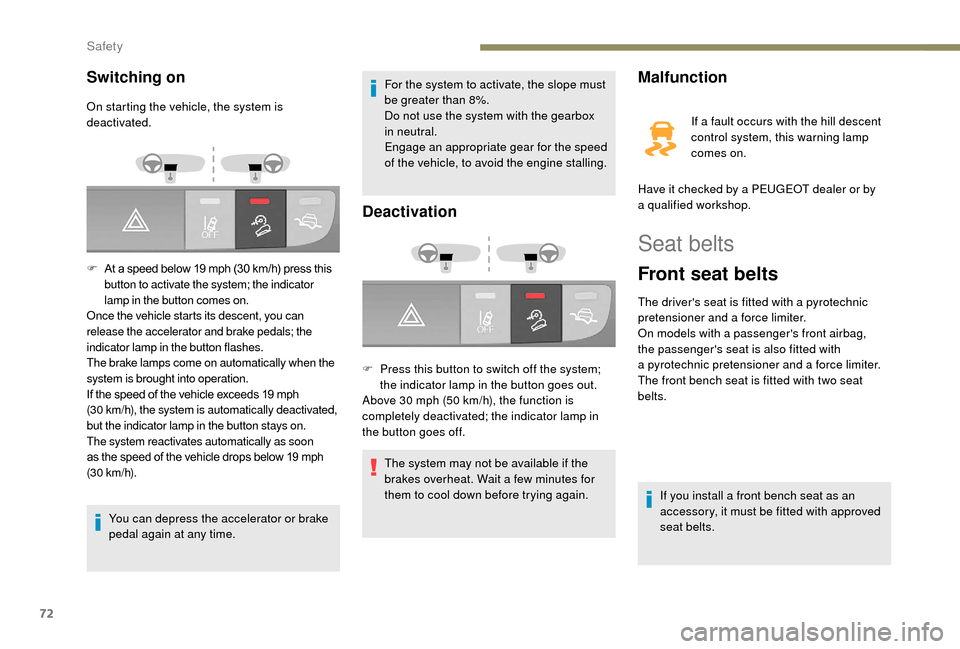
72
Seat belts
Front seat belts
The driver's seat is fitted with a pyrotechnic
p retensioner and a force limiter.
On models with a
passenger's front airbag,
the passenger's seat is also fitted with
a
pyrotechnic pretensioner and a force limiter.
The front bench seat is fitted with two seat
belts.
Switching on
On starting the vehicle, the system is
deactivated.
F
A
t a speed below 19 mph (30 km/h) press this
button to activate the system; the indicator
lamp in the button comes on.
Once the vehicle starts its descent, you can
release the accelerator and brake pedals; the
indicator lamp in the button flashes.
The brake lamps come on automatically when the
system is brought into operation.
If the speed of the vehicle exceeds 19
mph
(30
km/h), the system is automatically deactivated,
but the indicator lamp in the button stays on.
The system reactivates automatically as soon
as the speed of the vehicle drops below 19
mph
(30
km/h).You can depress the accelerator or brake
pedal again at any time. For the system to activate, the slope must
be greater than 8%.
Do not use the system with the gearbox
in neutral.
Engage an appropriate gear for the speed
of the vehicle, to avoid the engine stalling.
Deactivation
F Press this button to switch off the system;
the indicator lamp in the button goes out.
Above 30
mph (50 km/h), the function is
completely deactivated; the indicator lamp in
the button goes off.
The system may not be available if the
brakes overheat. Wait a
few minutes for
them to cool down before trying again.
Malfunction
If a fault occurs with the hill descent
c ontrol system, this warning lamp
comes on.
Have it checked by a
PEUGEOT dealer or by
a
qualified workshop.
If you install a
front bench seat as an
accessory, it must be fitted with approved
seat belts.
Safety
Page 91 of 232
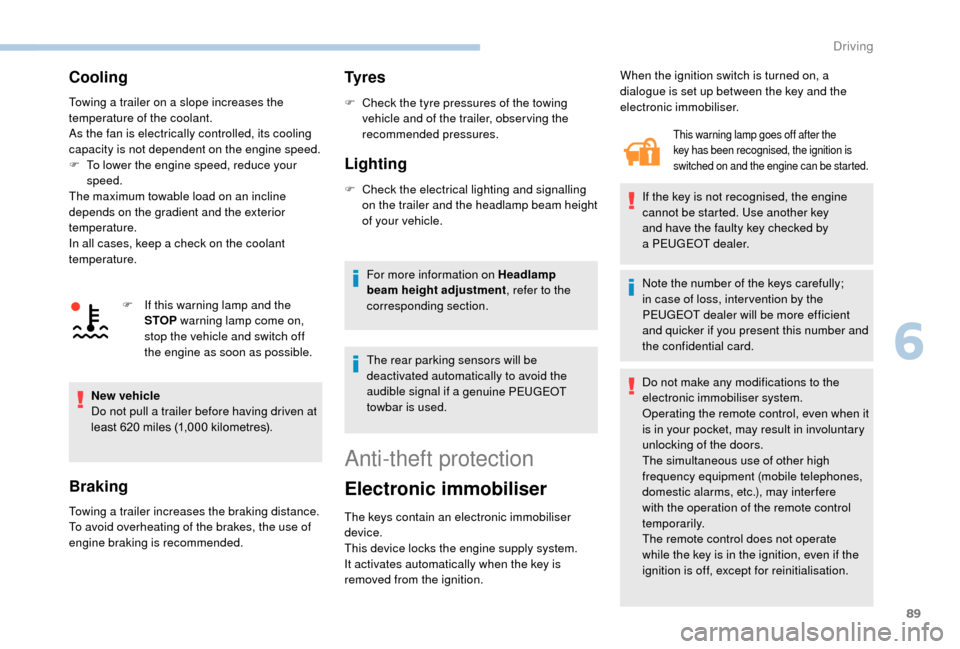
89
Cooling
Towing a trailer on a slope increases the
t emperature of the coolant.
As the fan is electrically controlled, its cooling
capacity is not dependent on the engine speed.
F
T
o lower the engine speed, reduce your
speed.
The maximum towable load on an incline
depends on the gradient and the exterior
temperature.
In all cases, keep a
check on the coolant
temperature.
F
I
f this warning lamp and the
STOP warning lamp come on,
stop the vehicle and switch off
the engine as soon as possible.
New vehicle
Do not pull a
trailer before having driven at
least 620
miles (1,000 kilometres).
Braking
Towing a trailer increases the braking distance.
T o avoid overheating of the brakes, the use of
engine braking is recommended.
Ty r e s
F Check the tyre pressures of the towing vehicle and of the trailer, observing the
recommended pressures.
Lighting
F Check the electrical lighting and signalling on the trailer and the headlamp beam height
of your vehicle.
For more information on Headlamp
beam height adjustment , refer to the
corresponding section.
The rear parking sensors will be
deactivated automatically to avoid the
audible signal if a
genuine PEUGEOT
towbar is used.
Anti-theft protection
Electronic immobiliser
The keys contain an electronic immobiliser
device.
This device locks the engine supply system.
It activates automatically when the key is
removed from the ignition.
This warning lamp goes off after the
key has been recognised, the ignition is
switched on and the engine can be started.
If the key is not recognised, the engine
cannot be started. Use another key
and have the faulty key checked by
a
PEUGEOT dealer.
Note the number of the keys carefully;
in case of loss, inter vention by the
PEUGEOT dealer will be more efficient
and quicker if you present this number and
the confidential card.
When the ignition switch is turned on, a
dialogue is set up between the key and the
electronic immobiliser.
Do not make any modifications to the
electronic immobiliser system.
Operating the remote control, even when it
is in your pocket, may result in involuntary
unlocking of the doors.
The simultaneous use of other high
frequency equipment (mobile telephones,
domestic alarms, etc.), may inter fere
with the operation of the remote control
temporarily.
The remote control does not operate
while the key is in the ignition, even if the
ignition is off, except for reinitialisation.
6
Driving